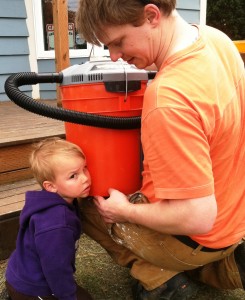Feral Bees!
 Last Saturday, I got a message from a fellow beekeeper friend about a swarm of honey bees she had spotted in her parents’ yard. The swarm in question had set down and formed a nice cluster around a tree branch about 20 feet above grade. This was only the second swarm I had heard about so far this year, so naturally, I got a little bit excited.
Last Saturday, I got a message from a fellow beekeeper friend about a swarm of honey bees she had spotted in her parents’ yard. The swarm in question had set down and formed a nice cluster around a tree branch about 20 feet above grade. This was only the second swarm I had heard about so far this year, so naturally, I got a little bit excited.
Just that morning I had discovered that another one of my hives in the apiary didn’t make it. The jury is still out on whether there is more Colony Collapse Disorder (CCD) at play, or if something else did them in. A quick look revealed no obvious signs of disease and there were plenty of food stores, so they didn’t starve. But in any case, it meant that I was down to one active hive, and I like to have at least two going at any given time for honey production.
So the prospect of being able to restock at least one hive by way of a captured swarm was very appealing. Unfortunately, we already had plans that afternoon, so I was unable to go and retrieve the swarm right then and there. I asked my friend if it seemed to her as if this swarm might likely stick around a bit, or if it was getting ready to make a move.
While the bees are in their cluster formation, they are very docile, and their number one priority is to protect the queen at the center of the cluster. Once the swarm has left the old hive and set down somewhere near by, designated scout bees get sent out to look for a suitable new home for the swarm. This process can take quite a while, so a swarm cluster may stick around for a couple of days. Check my page on honey bee swarms for more information.
My friend said that this swarm had been there a while already, but that it didn’t look like they were about to leave. We agreed to check in with each other the next morning – if the swarm was still there, I would come get it. Sunday morning came, and the ladies had not taken off yet, so I loaded up the Bee Mobile with the necessary tools and gear and headed for Lake Washington. It was a beautiful morning, and once I arrived at the secluded property, my friend showed me the location of the swarm.
She also pointed out an old dead tree in the back of the property, with a big trunk that was still mostly standing upright. Apparently, a few years ago a colony of honey bees had take up residence in a large hollow cavity inside the old tree, and the colony had been surviving in there on their own ever since.
Honey bees that are being kept by beekeepers are typically of the European Italian or Russian variety. However, once they escape the confines of a managed apiary, and are able to survive on their own in the wild, they are considered feral. Feral colonies differ from the semi-domesticated varieties in that no human input is given in the genetic selection of a new queen, and therefore the genetic makeup of all subsequent workers.
Once a feral colony has gone through several generations of wild-born and mated queens, the genetic stock can start to show certain adaptions to the environment, as genetic traits that are beneficial to survival are passed on whereas weaker traits are eliminated. These types of bees are sometimes also referred to as “survivor stock”, because they manage to survive in the wild without human management.
So there was a good chance that this particular swarm was actually feral! In the age of Colony Collapse Disorder, a more disease resistant colony might be very interesting. Of course I have no idea how well such a feral colony might do in the area of honey production, or how they feel about staying in a movable frame hive box.
 The actual capture of the swarm went without a hitch. I climbed up the ladder, held a bucket under the swarm cluster, and cut off a small piece of the branch to drop the entire cluster into the bucket. Put a lid on it: Done.
The actual capture of the swarm went without a hitch. I climbed up the ladder, held a bucket under the swarm cluster, and cut off a small piece of the branch to drop the entire cluster into the bucket. Put a lid on it: Done.
I used the bee vacuum to catch the majority of the stragglers that flew away when the branch started dropping. After I got back home, I let the Little Bee Man listen to the bucket containing all the bees. All the humming had him very curious!
After a quick feeding of delicious sugar syrup fortified with Honey-B-Healthy, I let the swarm get a night of rest in the bucket. The next morning, I installed the captured swarm in their own deep hive body box in my apiary. So far so good – four days later, they still seem to be there. I will leave them alone for a few more days before I’ll take a peak to check if I see any fresh eggs. If there was a queen at the center of the swarm cluster, and she survived the transport, then she should start laying new eggs pretty soon after arriving at the new location.





